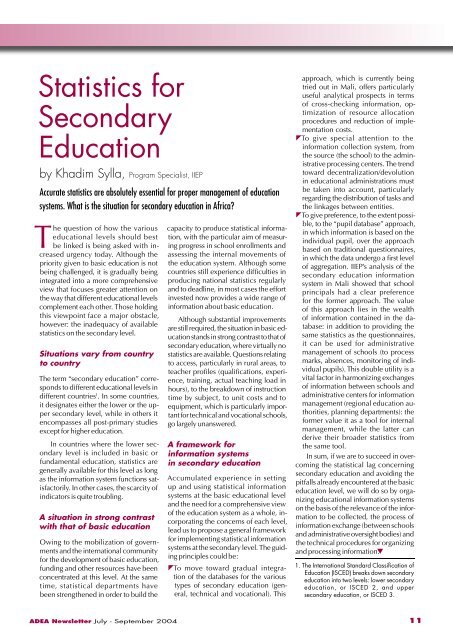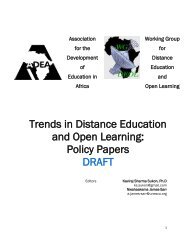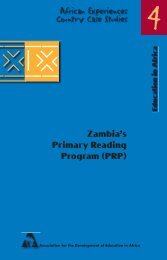Newsletter Vol.16 No.3 - ADEA
Newsletter Vol.16 No.3 - ADEA
Newsletter Vol.16 No.3 - ADEA
You also want an ePaper? Increase the reach of your titles
YUMPU automatically turns print PDFs into web optimized ePapers that Google loves.
Statistics forSecondaryEducationby Khadim Sylla, Program Specialist, IIEPAccurate statistics are absolutely essential for proper management of educationsystems. What is the situation for secondary education in Africa?The question of how the variouseducational levels should bestbe linked is being asked with increasedurgency today. Although thepriority given to basic education is notbeing challenged, it is gradually beingintegrated into a more comprehensiveview that focuses greater attention onthe way that different educational levelscomplement each other. Those holdingthis viewpoint face a major obstacle,however: the inadequacy of availablestatistics on the secondary level.Situations vary from countryto countryThe term “secondary education” correspondsto different educational levels indifferent countries 1 . In some countries,it designates either the lower or the uppersecondary level, while in others itencompasses all post-primary studiesexcept for higher education.In countries where the lower secondarylevel is included in basic orfundamental education, statistics aregenerally available for this level as longas the information system functions satisfactorily.In other cases, the scarcity ofindicators is quite troubling.A situation in strong contrastwith that of basic educationOwing to the mobilization of governmentsand the international communityfor the development of basic education,funding and other resources have beenconcentrated at this level. At the sametime, statistical departments havebeen strengthened in order to build thecapacity to produce statistical information,with the particular aim of measuringprogress in school enrollments andassessing the internal movements ofthe education system. Although somecountries still experience difficulties inproducing national statistics regularlyand to deadline, in most cases the effortinvested now provides a wide range ofinformation about basic education.Although substantial improvementsare still required, the situation in basic educationstands in strong contrast to that ofsecondary education, where virtually nostatistics are available. Questions relatingto access, particularly in rural areas, toteacher profiles (qualifications, experience,training, actual teaching load inhours), to the breakdown of instructiontime by subject, to unit costs and toequipment, which is particularly importantfor technical and vocational schools,go largely unanswered.A framework forinformation systemsin secondary educationAccumulated experience in settingup and using statistical informationsystems at the basic educational leveland the need for a comprehensive viewof the education system as a whole, incorporatingthe concerns of each level,lead us to propose a general frameworkfor implementing statistical informationsystems at the secondary level. The guidingprinciples could be: To move toward gradual integrationof the databases for the varioustypes of secondary education (general,technical and vocational). Thisapproach, which is currently beingtried out in Mali, offers particularlyuseful analytical prospects in termsof cross-checking information, optimizationof resource allocationprocedures and reduction of implementationcosts. To give special attention to theinformation collection system, fromthe source (the school) to the administrativeprocessing centers. The trendtoward decentralization/devolutionin educational administrations mustbe taken into account, particularlyregarding the distribution of tasks andthe linkages between entities.To give preference, to the extent possible,to the “pupil database” approach,in which information is based on theindividual pupil, over the approachbased on traditional questionnaires,in which the data undergo a first levelof aggregation. IIEP’s analysis of thesecondary education informationsystem in Mali showed that schoolprincipals had a clear preferencefor the former approach. The valueof this approach lies in the wealthof information contained in the database:in addition to providing thesame statistics as the questionnaires,it can be used for administrativemanagement of schools (to processmarks, absences, monitoring of individualpupils). This double utility is avital factor in harmonizing exchangesof information between schools andadministrative centers for informationmanagement (regional education authorities,planning departments): theformer value it as a tool for internalmanagement, while the latter canderive their broader statistics fromthe same tool.In sum, if we are to succeed in overcomingthe statistical lag concerningsecondary education and avoiding thepitfalls already encountered at the basiceducation level, we will do so by organizingeducational information systemson the basis of the relevance of the informationto be collected, the process ofinformation exchange (between schoolsand administrative oversight bodies) andthe technical procedures for organizingand processing information.▼1. The International Standard Classification ofEducation (ISCED) breaks down secondaryeducation into two levels: lower secondaryeducation, or ISCED 2, and uppersecondary education, or ISCED 3.<strong>ADEA</strong> <strong>Newsletter</strong> July - September 200411
















